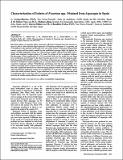Por favor, use este identificador para citar o enlazar a este item:
http://hdl.handle.net/10261/21307COMPARTIR / EXPORTAR:
 SHARE SHARE
 CORE
BASE CORE
BASE
|
|
| Visualizar otros formatos: MARC | Dublin Core | RDF | ORE | MODS | METS | DIDL | DATACITE | |

| Campo DC | Valor | Lengua/Idioma |
|---|---|---|
| dc.contributor.author | Corpas-Hervias, Consolación | - |
| dc.contributor.author | Melero-Vara, José M. | - |
| dc.contributor.author | Molinero-Ruiz, Leire | - |
| dc.contributor.author | Zurera-Muñoz, Carlos | - |
| dc.contributor.author | Basallote-Ureba, M. José | - |
| dc.date.accessioned | 2010-02-18T12:09:23Z | - |
| dc.date.available | 2010-02-18T12:09:23Z | - |
| dc.date.issued | 2006-11 | - |
| dc.identifier.citation | Plant Disesase 90:1441-1451 (2006) | en_US |
| dc.identifier.issn | 0191-2917 | - |
| dc.identifier.uri | http://hdl.handle.net/10261/21307 | - |
| dc.description | 11 pages; 7 tables; 4 figures | en_US |
| dc.description.abstract | Microbial analysis of asparagus plants (Asparagus officinalis) obtained from four nurseries in Spain in 2002 to 2003 indicated high frequencies of Fusarium proliferatum, F. oxysporum, and F. moniliforme in the rhizomes and storage roots. Out of 201 isolates of Fusarium obtained from nursery crowns and from plants sampled in nine established asparagus fields, the highest frequency of highly pathogenic isolates was observed from samples collected from fields, and included some extremely virulent isolates of F. solani. For isolates of low to moderate virulence, the percentage of those significantly (P = 0.01) associated with root dry weight loss was larger for F. proliferatum (53.8%) than for the other Fusarium species (10.3 to 23.1%). Random amplified polymorphic DNA (RAPD) analysis of 19 isolates of Fusarium spp. grouped all F. proliferatum and F. moniliforme isolates together and, in a second cluster, five of the eight isolates of F. oxysporum. Asparagus cultivars Verde-Morado and Dariana were the least susceptible of 11 cultivars commonly grown in Spain; isolates of F. solani and F. moniliforme proved highly virulent; and a significant interaction was observed among pathogen isolates and asparagus cultivars when representative pathogenic isolates of F. proliferatum, F. oxysporum, F. moniliforme, and F. solani were tested on those cultivars. Larger reductions in root dry weight were associated with F. proliferatum and F. solani than with F. oxysporum and F. moniliforme, and differences in root and stem dry weights among cultivars were significant. | en_US |
| dc.description.sponsorship | Ministerio de Agricultura, Pesca y Alimentación. Project INIA RTA 02-216. Spain IFAPA/ASOCIAFRUIT. Project CO-011. Spain | en_US |
| dc.format.extent | 536602 bytes | - |
| dc.format.mimetype | application/pdf | - |
| dc.language.iso | eng | en_US |
| dc.publisher | American Phytopathological Society | en_US |
| dc.rights | openAccess | en_US |
| dc.subject | Crown and root rot | en_US |
| dc.subject | Cultivar susceptibility | en_US |
| dc.subject | Fingerprinting | en_US |
| dc.title | Characterization of isolates of Fusarium spp. obtained from asparagus in Spain | en_US |
| dc.type | artículo | en_US |
| dc.identifier.doi | 10.1094/PD-90-1441 | - |
| dc.description.peerreviewed | Peer reviewed | en_US |
| dc.relation.publisherversion | http://dx.doi.org/10.1094/PD-90-1441 | en_US |
| dc.type.coar | http://purl.org/coar/resource_type/c_6501 | es_ES |
| item.cerifentitytype | Publications | - |
| item.openairecristype | http://purl.org/coar/resource_type/c_18cf | - |
| item.grantfulltext | open | - |
| item.openairetype | artículo | - |
| item.fulltext | With Fulltext | - |
| item.languageiso639-1 | en | - |
| Aparece en las colecciones: | (IAS) Artículos | |
Ficheros en este ítem:
| Fichero | Descripción | Tamaño | Formato | |
|---|---|---|---|---|
| Plant Disease 90 (11)1441-1451.pdf | 524,03 kB | Adobe PDF |  Visualizar/Abrir |
CORE Recommender
SCOPUSTM
Citations
38
checked on 22-abr-2024
WEB OF SCIENCETM
Citations
35
checked on 27-feb-2024
Page view(s)
391
checked on 06-may-2024
Download(s)
391
checked on 06-may-2024
Google ScholarTM
Check
Altmetric
Altmetric
NOTA: Los ítems de Digital.CSIC están protegidos por copyright, con todos los derechos reservados, a menos que se indique lo contrario.
